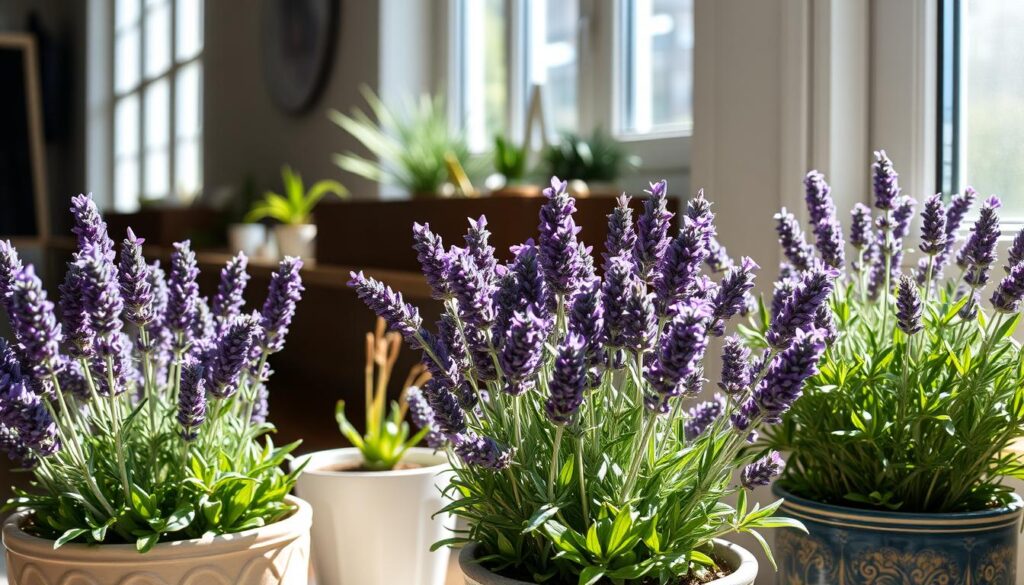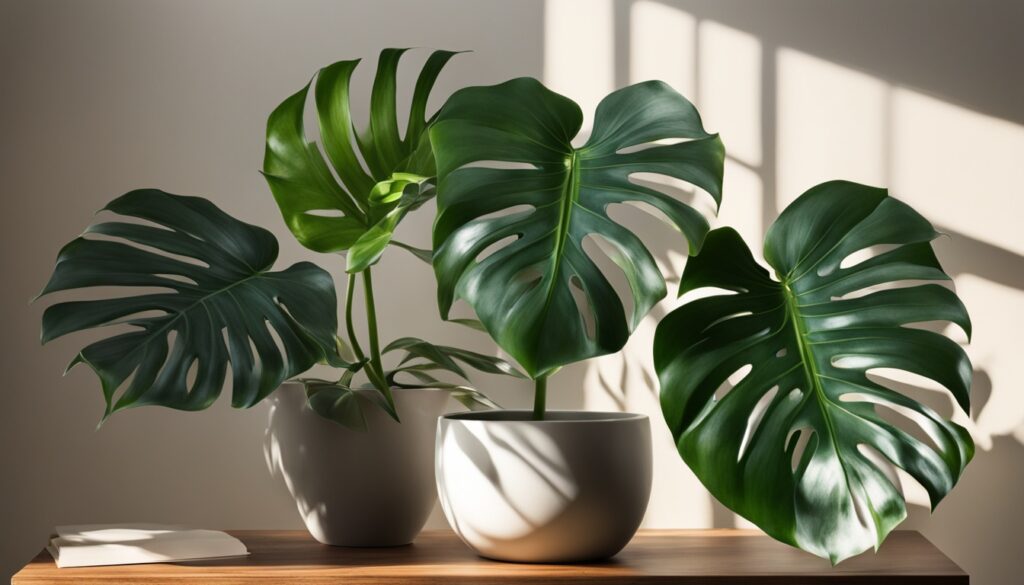Lavender is a fragrant perennial shrub known for its calming purple blooms and gray-green leaves. It’s a favorite among gardeners. But can it thrive indoors, away from sunlight and outdoor conditions? The answer might surprise you.
Growing lavender indoors comes with its own set of challenges. But with the right care, you can grow this versatile plant indoors. Lavender indoor cultivation brings many benefits, like purifying the air and controlling pests. It’s a great choice to improve your living space.
Key Takeaways
- Lavender can be grown indoors with the right conditions, including ample sunlight, well-draining soil, and proper watering techniques.
- Indoor lavender cultivation provides year-round enjoyment and offers benefits like air purification and natural pest control.
- Choosing the right lavender variety, such as French lavender, is crucial for success in an indoor setting.
- Maintaining optimal temperature and humidity levels is essential for the health and thriving of indoor lavender plants.
- Proper pruning and fertilization are key to promoting lush, fragrant growth and preventing common indoor lavender challenges.
Understanding Indoor Lavender Cultivation
To grow lavender indoors, you need to know about the different indoor lavender varieties. Each type, from French lavender to Canary Island and fernleaf, has its own needs. These needs help them thrive indoors.
Types of Indoor Lavender Varieties
Here are some popular indoor lavender types:
- French Lavender (Lavandula stoechas) – It has purple-pink flowers and grows compactly, perfect for indoors.
- Canary Island Lavender (Lavandula canariensis) – This rare variety has silvery-gray leaves and long-lasting purple flowers.
- Fernleaf Lavender (Lavandula multifida) – It has fern-like leaves and vibrant purple flowers, adding elegance indoors.
Benefits of Growing Lavender Inside
Growing lavender indoors has many benefits. You can enjoy its fragrance all year, it helps calm and reduce stress, and it can keep pests away. Plus, its beauty can make any room feel more welcoming.
Basic Requirements Overview
To grow indoor lavender well, you need to give it the right conditions. It needs lots of sunlight (at least 3-4 hours a day), well-draining soil, and a cool temperature (50-70°F). With the right care, indoor lavender can flourish and add beauty to your home.
Can You Grow Lavender Inside: Essential Requirements
Growing lavender indoors is possible, but it needs specific conditions. These conditions ensure the plants thrive and offer beauty and fragrance. Understanding the needs for lavender indoor conditions and lavender indoor environment is key.
Lavender needs plenty of sunlight to grow well. It needs at least three to four hours of direct sunlight each day. Placing your lavender in a south-facing window or using LED grow lights can help.
The ideal temperature for indoor lavender is between 50-70°F. In spring and mid-fall, keep it at 70°F during the day and 50-55°F at night. Adjust the temperature as the seasons change, keeping it cooler at night and warmer during the day.
Choosing the right soil and drainage is also important. Lavender prefers well-draining, slightly gritty soil with a pH of 7-8. A mix of compost and cactus soil works well. Make sure the pot has holes to prevent waterlogging.
Keeping humidity right is another key factor. Lavender needs good air circulation but avoid direct forced-air heat. This can dry out the leaves and stress the plant.
| Requirement | Ideal Conditions |
|---|---|
| Sunlight | Minimum 3-4 hours of direct sunlight daily |
| Temperature | 50-70°F, with 50-55°F at night and 70°F during the day |
| Soil | Well-draining, slightly gritty, pH 7-8 |
| Humidity | Good air circulation, avoid direct forced-air heat |
By meeting these requirements for lavender indoor conditions and lavender indoor environment, you can grow thriving lavender at home. Enjoy their beauty and fragrance all year.
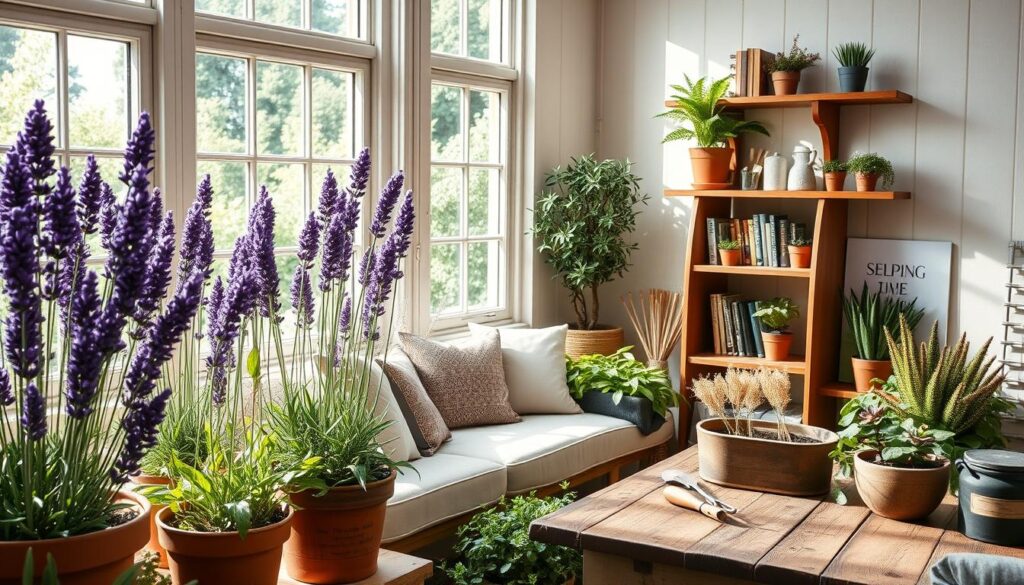
Choosing the Right Lavender Variety for Indoor Growing
Choosing the right lavender variety is key for indoor growing. Full-size lavender plants like Lavandula angustifolia do best outside. But, there are dwarf and adaptable varieties that do great indoors. These smaller plants are perfect for small spaces and container gardening.
French Lavender for Indoor Success
French lavender (Lavandula dentata) is a top pick for indoor growing. It blooms for a long time, making it perfect for indoor use. French lavender grows well in containers and adds a lovely scent all year.
Canary Island Lavender Features
Canary Island lavender (Lavandula canariensis) is also great for indoors. It has unique fernlike leaves and bright purple flowers. This variety loves sunny spots, making it ideal for indoor spaces.
Fernleaf Lavender Characteristics
Fernleaf lavender (Lavandula multifida) is another good choice for indoors. It has delicate leaves and lots of flowers. This compact plant is easy to grow in containers, adding a Mediterranean feel to your home.
When picking an indoor lavender, think about size, how long it blooms, and how it does in containers. The right variety will bring the beauty and scent of lavender into your home all year.
| Lavender Variety | Characteristics | Ideal for Indoor Growing |
|---|---|---|
| French Lavender (Lavandula dentata) | Hardy, longer flowering period | Yes |
| Canary Island Lavender (Lavandula canariensis) | Distinctive fernlike foliage, vibrant purple flowers | Yes |
| Fernleaf Lavender (Lavandula multifida) | Delicate, lacy foliage, abundant flowers | Yes |
Perfect Light Conditions for Indoor Lavender
Lavender loves the sun and grows best in full sun. To grow lavender indoors, you need to give it the right light. Aim for 3-4 hours of direct sunlight each day, best in a south-facing window. If sunlight is scarce, use LED grow lights 14-30 inches above the plant for 12+ hours a day.
Good lighting is key for lavender’s growth and flowers. Without enough light, it may grow weak and not bloom much. To make sure it gets even light, turn the plant’s pot every week. With the right lavender indoor conditions, your lavender houseplant will thrive and bloom beautifully.
“Lavender thrives in warm temperatures and requires at least 6-8 hours of full sun per day for proper growth.”
Lighting Tips for Indoor Lavender
- Provide a minimum of 3-4 hours of direct sunlight daily, ideally in a south-facing window.
- Supplement natural light with LED grow lights for 12+ hours per day, placed 14-30 inches above the plant.
- Rotate the pot weekly to ensure uniform growth and prevent legginess.
| Lighting Requirement | Optimal Condition |
|---|---|
| Daily sunlight exposure | 3-4 hours of direct sunlight |
| Supplemental grow light duration | 12+ hours per day |
| Grow light placement | 14-30 inches above the plant |
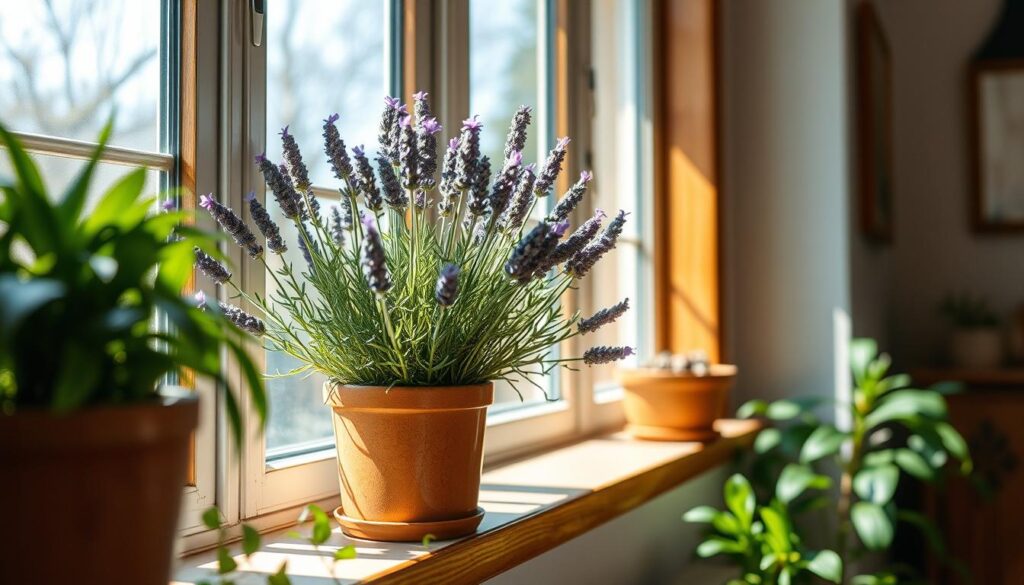
Temperature and Humidity Requirements
Keeping the right temperature and humidity is key for growing lavender plants indoors. The best temperature changes with the seasons. In colder months, it’s better to keep it a bit cooler.
Seasonal Temperature Adjustments
In spring to fall, lavender loves a night of 50-55°F and a day of about 70°F. But in late fall and winter, it prefers a night of 45-50°F and a day of 60-65°F.
Humidity Control Methods
Lavender likes a dry air, best at 40% humidity or less. To keep it dry, don’t put lavender near heaters or air vents. If it’s too humid, a dehumidifier can help.
| Season | Night Temperature | Day Temperature | Ideal Humidity |
|---|---|---|---|
| Spring-Fall | 50-55°F | 70°F | Around 40% or lower |
| Late Fall-Winter | 45-50°F | 60-65°F | Around 40% or lower |
By watching and adjusting the temperature and humidity, you can make a perfect home for your lavender houseplant care. This will keep your indoor lavender plants healthy and bright.
Soil and Potting Requirements for Indoor Lavender
Growing lavender indoors needs the right soil and potting conditions. Lavender loves [lavender potted plant] well-draining, slightly gritty soil. Mix a high-quality potting soil with cactus or succulent mix for the best results. This blend ensures good drainage and aeration.
Heavy clay soils are bad for lavender. They can cause waterlogging and root rot. So, avoid them.
Repot your indoor [lavender container gardening] lavender every year or every two years. Choose a pot that’s 1-2 inches bigger than the root ball. This gives the plant room to grow. Make sure the pot has lots of drainage holes to prevent water buildup.
“Lavender plants thrive in well-drained, slightly gritty soil and do not do well in heavy clay soils.”
With the right soil and potting setup, your indoor lavender garden will flourish. It will beautify your space and fill it with a lovely scent.
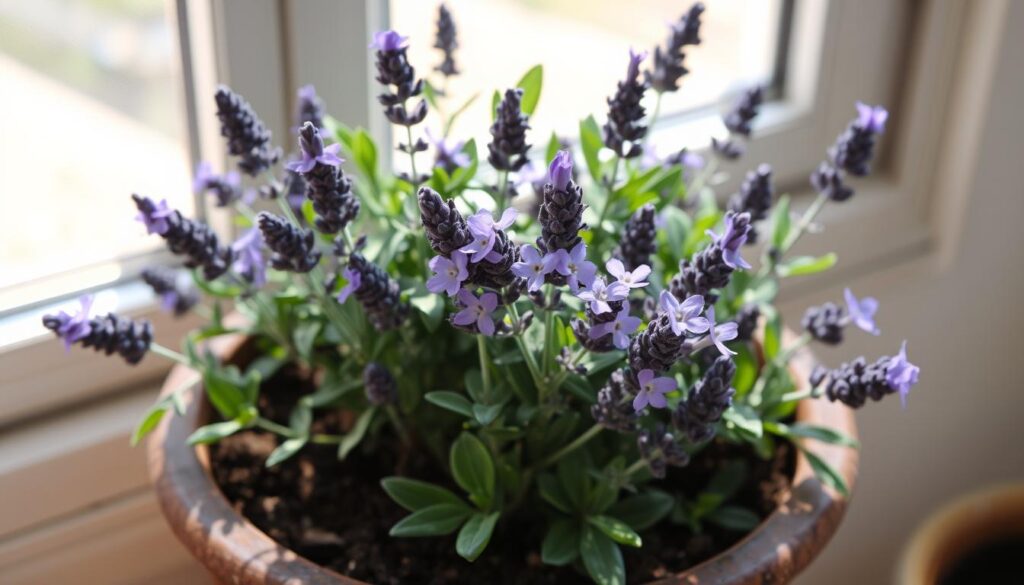
Proper Watering Techniques and Schedule
Getting the watering right is key for your indoor lavender houseplant care and growing lavender indoors. Water your lavender plants well when the top few inches of soil feel dry. This usually happens every 10-14 days. Make sure to soak the soil but let it dry out a bit before watering again to avoid too much water.
Signs of Over and Under Watering
Watch for signs that your lavender might be getting too much or too little water. Yellow leaves and root rot mean it’s getting too wet. On the other hand, if the leaves start to wilt, it’s a sign of not enough water. Keep an eye on your plants to adjust the watering just right.
Drainage Considerations
Good drainage is vital for your indoor lavender’s health. Ensure your pots or containers have holes to let excess water out. This prevents water from staying too long and causing root rot. Also, using a potting mix that drains well can help avoid too much water.
| Watering Frequency | Soil Moisture | Optimal Conditions |
|---|---|---|
| Every 10-14 days | Top few inches should be dry | Thoroughly water, allow soil to dry between waterings |
By sticking to these watering tips and a good schedule, your indoor lavender will flourish and stay healthy all year.
Indoor Lavender Container Selection
Choosing the right container is key for growing lavender indoors. Pick a pot that’s 1-2 inches bigger than the plant’s root ball. Terracotta pots are great because they help soak up extra moisture and ensure good drainage.
Make sure the container has holes for water to drain. This stops water from pooling and causing root rot. The pot’s size also impacts how often you’ll need to water and how big the lavender will grow. Choose a size that fits your plant and the space you have indoors.
| Lavender Variety | Recommended Pot Size |
|---|---|
| French Lavender | 6-8 inches in diameter |
| Canary Island Lavender | 8-10 inches in diameter |
| Fernleaf Lavender | 6-8 inches in diameter |
By picking the right container and thinking about drainage and size, you can make a great spot for your lavender container gardening or lavender potted plant. This will help it grow well and look beautiful indoors.
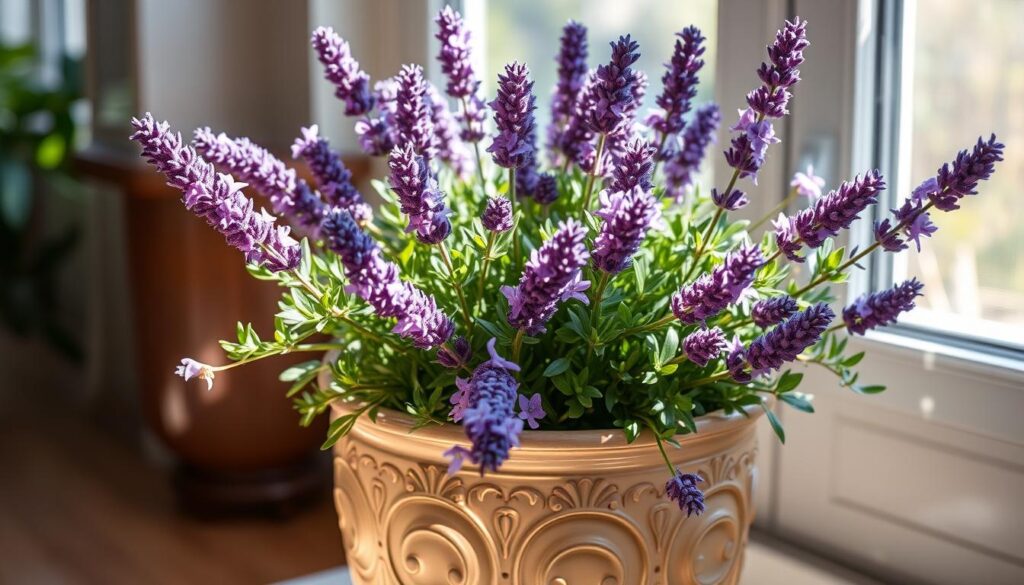
Over the past few years, the likelihood of successful growth from lavender seeds has increased due to advancements in seed quality, resulting in more consistent plant characteristics.
Fertilization and Nutrient Requirements
Proper fertilization is key for your indoor lavender houseplant to stay healthy and bloom well. Feed it with organic container plant food or water-soluble fertilizer in spring and summer. Use half the recommended strength every four weeks.
Don’t overdo it with the fertilizer. Lavender likes lean, well-draining soil. Too much can hurt its fragrance and flowers. It can also make it grow too much foliage instead of blooms. So, aim for a balanced diet for your lavender indoor cultivation.
| Nutrient Requirements | Recommended Fertilizer |
|---|---|
| Initial Planting | Balanced Blend (NPK 10-10-10) |
| Ongoing Growth | Herb Blend (NPK 10-5-5) |
By following these lavender houseplant care tips, your indoor lavender will get the nutrients it needs. It will bloom abundantly, making your space more welcoming.
“Lavender is a low-maintenance plant that doesn’t require heavy feeding, but providing the right nutrients at the right time can make a big difference in its growth and performance.”
Pruning and Maintenance Guidelines
Proper care for your indoor lavender plants is key to their health and beauty. There are important guidelines for pruning and maintenance to follow for the best results.
Seasonal Pruning Tips
Prune your lavender after the first spring bloom and again in the fall. This helps it grow bushier and keeps its shape. Cut back about one-third of the plant to encourage new, lush growth.
Promoting Bushier Growth
- Harvest lavender flowers often to encourage new growth.
- Tip-prune the plant now and then for a fuller look.
- Don’t prune too much, as it can cut down on flowers.
By using these seasonal pruning tips and care practices, you can keep your indoor lavender houseplant care and growing lavender indoors thriving. Your plants will stay vibrant and healthy for many years.
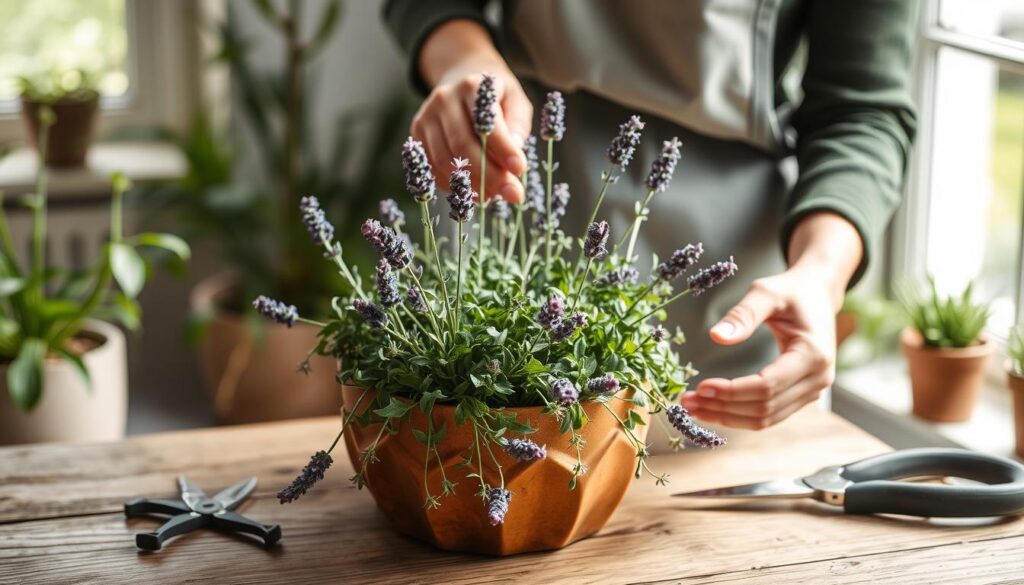
| Pruning Technique | Timing | Purpose |
|---|---|---|
| Cut back 1/3 of the plant | After first spring flowering, again in fall | Promote bushier growth |
| Harvest flowers regularly | Throughout growing season | Encourage new growth |
| Tip-prune occasionally | As needed | Create fuller appearance |
“Proper pruning and maintenance are essential for keeping indoor lavender plants thriving and looking their best.”
Common Indoor Lavender Growing Challenges
Growing lavender indoors can be rewarding but comes with challenges. To keep your lavender plants healthy, you need to pay attention to a few key things.
Lavender needs lots of sunlight to thrive. It should get at least six hours of direct sunlight every day. Without enough light, the plants can become weak and fail to bloom well. Placing them near south-facing windows or using grow lights can help.
Another big problem is overwatering. Lavender likes dry soil and doesn’t like too much water. Too much moisture can cause root rot, a disease that harms the plant. It’s important to check the soil moisture and water only when needed.
- Pests like spider mites, scale insects, and mealybugs can also be a problem. These pests eat the plant’s leaves, weakening it. Keeping an eye out and using natural pest control is key to a healthy plant.
- Poor air circulation can lead to fungal diseases like powdery mildew and botrytis. Good air flow around the plants helps prevent these issues. You can use fans or place plants in a way that improves air circulation.
By taking care of these common issues, you can grow healthy lavender indoors. Your home will smell great and look beautiful with these plants.
| Common Indoor Lavender Issues | Causes | Solutions |
|---|---|---|
| Weak, leggy growth | Insufficient light | Place plants in south-facing windows or use grow lights |
| Root rot | Overwatering | Monitor soil moisture and adjust watering schedule |
| Pest infestations | Spider mites, scale insects, mealybugs | Use organic pest control methods |
| Fungal diseases | Poor air circulation | Ensure adequate airflow around plants |
Harvesting and Using Indoor Lavender
Growing lavender indoors is rewarding, giving you a steady supply of this fragrant herb. Harvesting and using your indoor lavender requires a few key tips.
The best time to harvest lavender is when the flowers are in full bloom. This usually happens in the morning, after the dew has dried. Use sharp scissors or pruning shears to cut the stems, leaving a few inches attached to the flower heads.
- Harvest lavender in the morning for the best essential oil content.
- Cut stems just below the flower heads, leaving a few inches of stem.
- Avoid harvesting in the heat of the day or after rain, as this can reduce the essential oils.
After harvesting, you can use lavender in many ways. Fresh lavender is great for teas, cocktails, or aromatherapy. To keep lavender for longer, dry the stems and flower heads.
- Dry lavender by hanging the stems upside down in a cool, dry, and well-ventilated area.
- Store dried lavender in airtight containers, away from direct sunlight, to maintain the fragrance and potency.
- Use dried lavender in sachets, potpourri, or as a natural insect repellent.
Regularly harvesting your indoor lavender keeps it blooming and healthy. With the right care, your indoor lavender can thrive for years.
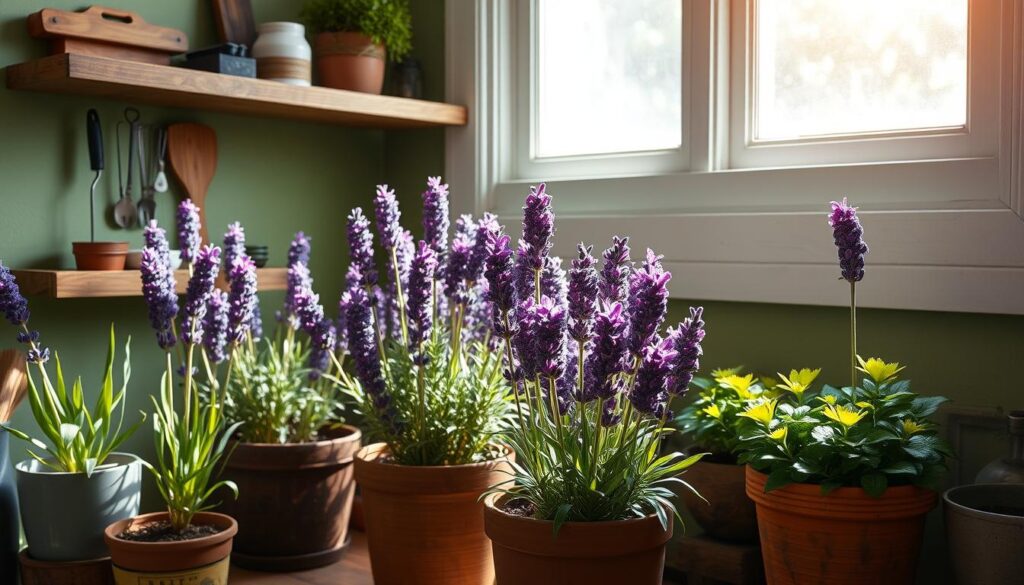
“Lavender is one of the most versatile and beloved herbs, with a calming aroma and a wide range of uses.”
Moving Lavender Plants Between Indoors and Outdoors
When you move your indoor lavender plants outside, you need to be careful. This ensures they stay healthy and thrive. Start by gradually getting them used to the outdoors after the last frost.
Seasonal Transition Tips
First, put the lavender in a spot that’s partly shaded for a few hours a day. Slowly increase the time it spends outside over a few days. This helps the plant get used to the new light, temperature, and air.
After it adjusts, move it to a sunny spot. It should get three to four hours of direct sunlight.
Acclimatization Process
Before bringing lavender plants inside for winter, check them for pests or diseases. Adjust their watering since indoor plants need less water than outdoor ones. Lavender plants moved inside might dry out faster because of the sun and wind they got outside.
